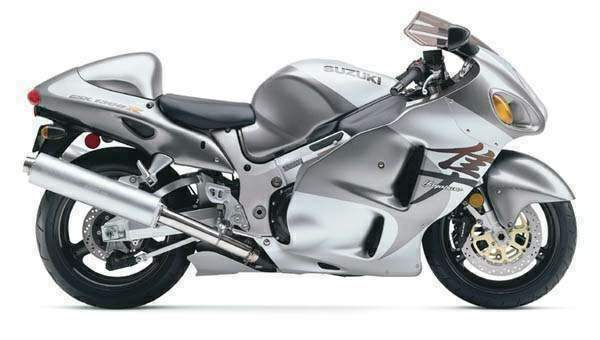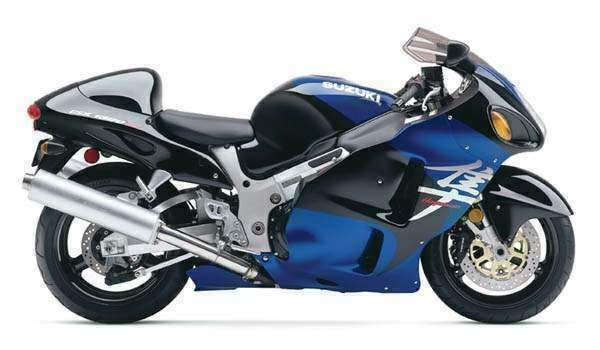
|
|
|
|
|
|
Classic Bikes
Custom Bikes
Individual
Racing Bikes AJP
AJS
Aprilia
Ariel
Avinton / Wakan
Bajaj
Benelli
Beta
Bimota
BMW
Brough Superior
BRP Cam-Am
BSA
Buell / EBR
Bultaco
Cagiva
Campagna
CCM
CF Moto
Combat Motors
Derbi
Deus
Ducati
Excelsior
GASGAS
Ghezzi Brian
Gilera
GIMA
Harley Davidson
Hero
Highland
Honda
Horex
Husaberg
Husqvarna
Hyosung
Indian
Jawa
Kawasaki
KTM
KYMCO
Laverda
Lazareth
Magni
Maico
Mash
Matchless
Mondial
Moto Guzzi
Moto Morini
MV Agusta
MZ / MuZ
NCR
Norton
NSU
Paton
Peugeot
Piaggio
Revival Cycles
Roland Sands
Royal Enfield
Sachs
Sherco
Sunbeam
Suzuki
SWM
SYM
Triumph
TVS
Ural
Velocette
Vespa
Victory
Vincent
VOR
Voxan
Vyrus
Walt Siegl
Walz
Wrenchmonkees
Wunderlich
XTR / Radical
Yamaha
Zero
Video
Technical
Complete Manufacturer List
|
Suzuki GSX 1300R Hayabusa
|
| . |
|
Make Model |
Suzuki GSX 1300R Hayabusa |
|
Year |
1999 |
|
Engine |
Four stroke, transverse four cylinder, DOHC, 4 valves per cylinder |
|
Capacity |
1298 cc / 79.2 u in |
| Bore x Stroke | 81 x 63 mm |
| Compression Ratio | 11.0:1 |
| Cooling System | Liquid cooled |
| Lubrication | Wet sump |
| Engine Oil | 10W/40 |
|
Induction |
Mikuni Denso Fuel Injection |
|
Ignition |
Electronic |
| Spark Plug | NGK, CR9E |
| Starting | Electric |
|
Max Power |
127.6 kW / 175 hp @ 9800 rpm |
|
Max Torque |
138 Nm / 14.07 kg-m / 102 lb-ft @ 7000 rpm |
| Clutch | Wet, multiple discs, hydraulic operated |
|
Transmission |
6 Speed |
| Final Drive | #530 chain |
| Frame | Twin-spar (Aluminum Alloy) |
|
Front Suspension |
Inverted telescopic, coil spring, fully adjustable spring preload, rebound and compression damping |
| Front Wheel Travel | 120 mm / 4.7 in |
|
Rear Suspension |
Link-type, gas/oil damped, fully adjustable spring preload, compression damping, and rebound damping |
| Rear Wheel Travel | 140 mm / 5.5 in |
|
Front Brakes |
2 x 320mm Discs, 6 piston calipers |
|
Rear Brakes |
Single 240mm disc, 2 piston caliper |
|
Front Tyre |
120/70 ZR17 |
|
Rear Tyre |
190/50 ZR17 |
| Rake | 24.2° |
| Trail | 98 mm / 3.8 in |
|
Dimensions |
Length 2140 mm / 84.3 in Width 740 mm / 29.1in Height 1155 mm / 45.5 in |
| Wheelbase | 1480 mm / 58.3in |
| Seat Height | 805 mm / 31.7 in |
|
Dry Weight |
217 kg / 480 lbs |
|
Fuel Capacity |
21 Litres / 5.5 US gal / 4.6 Imp gal |
|
Consumption average |
5.9 L/100 km / 16.9 km/l / 39.8 US mpg / 47.7 Imp mpg |
|
Standing 0 - 100km |
3.0 sec |
|
Standing 0 - 140km |
4.5 sec |
|
Standing 0 - 200km |
7,2 sec. |
|
Standing ¼ Mile |
10.3 sec / 232 km/h / 144 mph |
|
Top Speed |
306 km/h / 190.1 mph |
| . |
Overview
When first shown to the press in 1999, the first Hayabusas made a profound impression. No previous motorcycle has broken the production model top speed record by such a margin, 16 to 23 km/h (10 to 14 mph), depending on which measured speeds the source was relying on for the CBR1100XX and the GSX-1300R.
Hayabusa (隼) is Japanese for "peregrine falcon", a bird that often serves as a metaphor for speed due to its vertical hunting dive, or stoop, speed of 290 to 325 km/h (180 to 202 mph), the fastest of any bird.[26][27] In particular, the choice of name was made because the peregrine falcon preys on blackbirds,[28] which reflected the intent of the original Hayabusa to unseat the Honda CBR1100XX Super Blackbird as the world's fastest production motorcycle.[29][30][31] Eventually, the Hayabusa managed to surpass the Super Blackbird by at least a full 16 km/h (10 mph).
The first generation had a 1,299 cc (79.3 cu in) liquid-cooled, inline-4 engine with sixteen valves driven by double-overhead cams. This configuration, technologically unremarkable for that time, delivered a record-setting claimed 129 kW (173 bhp) at the crankshaft by virtue of the largest displacement ever in a sport bike, and a ram air system that forced cool, pressurized air into the cylinders at speed.[5][22] Combined with sophisticated aerodynamics, this powerful engine pushed the Hayabusa's top speed far above the Honda CBR1100XX Blackbird by a significant leap, contrasting with the incremental gains that preceded the Suzuki hyper sport entry. The 1997 carbureted CBR1100XX had previously only inched past the previous top speed record holder, the Kawasaki Ninja ZX-11 of 1990.

The Hayabusa's abundance of power at any engine speed made the Hayabusa easier to ride by giving the rider a greater choice of gear selection for a given speed and stunning acceleration.
The ram air ducts at the front of the drooping, rounded nose squeezed frontal area away from the headlight, and this, along with the need for a narrow frontal area, necessitated a stacked headlight and high beam behind a single lens. Moreover, the need to reduce the extreme drag encountered at high speeds determined the Hayabusa's entire bulbous, and much-criticized, bodywork design. Koblenz remarked, "non-traditional styling generates the main controversy of the Hayabusa."[22] When viewed through the eyes of those who judged its beauty on the basis of its functionality, or given a little time to get used to it, the bike's looks did find admirers.[22][33] The striking two-tone copper/silver paint scheme was similarly loved by some and hated by others, but was successful if the intent of an all-new, flagship product is to make a bold statement. So while it was called ugly by some in the press, this aerodynamic shape was key to the Hayabusa's ability to reach record-setting speeds.
Reflecting in 2009 on the initial design, the creator of the Hayabusa's look, Suzuki's Koji Yoshirua, said that the intent in 1999 was, "to create a somewhat grotesque design and create a strong initial impact... The mission was to create a total new styling that will not be out of date within few years, and a styling that will be the 'Face' of Suzuki." Yoshirua also said that the goal was not to achieve the status of fastest production motorcycle, which in early stages was slated to be only 900 to 1,100 cc (55 to 67 cu in), but that, "as a consequence of, pursuing the best handling, acceleration, safety, power, riding ability, original styling, etc., for the good of the customers, it became the 'Fastest production motorcycle' … By doing this, once the model was out in the market and the performance of it have been proven, I thought that people will start to show interest to the weird design, and then the design would be caked in peoples mind."
The engine used a gear-driven counterbalancer to reduce vibration to the point that the engine could be solidly mounted to the frame, for the purpose of increasing chassis rigidity. Employing a conventional twin beam frame, fully adjustable upside down forks, using specially developed Bridgestone tires, and being relatively light at 473 pounds (215 kg) dry, the Hayabusa's handling was considered excellent for a machine of this class.[5] One reviewer, Koblenz, noted a hesitation perhaps related to poor low-rpm mapping at low speeds, noticeable as a "pause and slight lurch" when rolling on and back off the throttle.

With rumors and then pre-release announcements of much greater power in Kawasaki's Ninja ZX-12R in 2000, clearly attempting to unseat Suzuki and regain lucrative bragging rights, the speed war appeared to be escalating. There were growing fears of carnage and mayhem from motorcycles getting outrageously faster every year, and there was talk of regulating hyper sport motorcycles, or banning their import to Europe.
|
Any corrections or more information on these motorcycles will be kindly appreciated. |